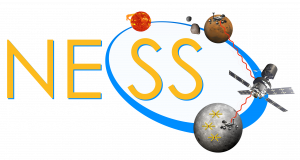How is hydrogen ionized?
Hydrogen is the simplest of all atoms: normal hydrogen consists of a single proton, with a positive electric charge, and a single electron, with a negative charge. The mutual electrical attraction of these particles holds the atom together, but if light with enough energy hits the atom, it can knock the electron free. This is called ionization. At the beginning of the Cosmic Dawn – during the Universe’s Dark Ages – nearly all of its hydrogen was electrically neutral, with a proton and an electron bound together. But stars – at least those much more massive than our own Sun – produce a great deal of ionizing light, and can tear these atoms apart.
Image: IC 342, and its core which is a specific type of central region known as an HII nucleus - a name that indicates the presence of ionized hydrogen - that is likely to be creating many hot new stars.
Credit: ESA/Hubble, NASA
How did galaxies reionize the Universe?
All galaxies produce massive stars, which in turn produce ionizing light. But most stars are formed deep inside their galaxies, and today the hydrogen gas of those galaxies absorbs nearly all the ionizing light, preventing it from escaping. However, during the Cosmic Dawn, astronomers believe that the small galaxies were violent places, full of swirling gas that occasionally opened up escape paths for that ionizing light. Once it escaped, that light would be absorbed by hydrogen gas surrounding the galaxy – making a bubble of ionized gas around each galaxy. But these galaxies were common enough that those bubbles quickly overlapped. As more and more galaxies formed, and as each galaxy grew larger, their bubbles grew and merged, until they filled the Universe. This is reionization: the last time in the history of the Universe when hydrogen throughout the Universe changed its state. Studying the process will help us learn both about the hydrogen gas pervading the Universe and about the galaxies driving reionization – even those we cannot see individually.
Image: This infrared image from NASA's Spitzer Space Telescope shows in the Milky Way in the constellation Aquila, a cloud of gas and dust full of bubbles, which are inflated by wind and radiation from massive young stars.
Credit: JPL, NASA/JPL-Caltech
When did reionization occur?
Astronomers have worked hard over the past twenty years to understand reionization, and they have learned a great deal about when it happened (about a billion years after the Big Bang). The hydrogen gas itself produces only the weakest of light (in the spin-flip background, which has not yet been observed in this period), these techniques are all based on finding a distant source of light and observing how the intervening gas affects that source's light. For details on some such methods, see below. But we cannot yet study the how of reionization: no observations exist yet that can probe the growth of ionized bubbles in the Universe.
Image: 'Snapshots' of reionization according to a computer simulation.
Credit: McQuinn et al. 2007, The Astrophysical Journal, vol. 377, pp. 1043-1063.
How does reionization affect the Universe?
Reionization is fascinating on its own terms, because it teaches us both about galaxies during the Cosmic Dawn and the remaining matter at that time - when only about 5% of the Universe's hydrogen was inside a galaxy! But it also has important implications for later generations of galaxies. In addition to ionizing the gas, reionization also heats it - likely by a factor of several thousand. The increased gas temperature makes it harder for other galaxies, especially small ones, to attract this gas. Thus reionization shifts galaxy growth toward larger objects, halting some of the smallest from continuing to form stars. This effect may even explain the properties of some of the Milky Way galaxy's smaller neighbors.
Image: The Large Magellanic Cloud, a satellite galaxy of the Milky Way, floats in space, in a long and slow dance around our galaxy.
Credit: NASA Goddard


